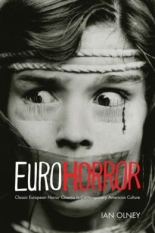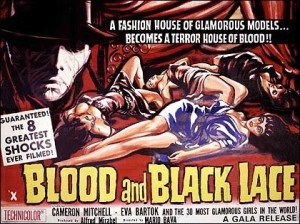
 A fine line exists between European arthouse films and European horror films, argues Ian Olney, and he makes a convincing case for it in Euro Horror, a paperback study for Indiana University Press.
A fine line exists between European arthouse films and European horror films, argues Ian Olney, and he makes a convincing case for it in Euro Horror, a paperback study for Indiana University Press.
Of course, many closed-minded people think no line exists between horror and pornography, so Olney also spends a great deal of time drawing one, while admitting similarities. In both instances, it has helped horror’s cause that lavish DVD editions have rescued the films from obscurity; such discs’ all-out-extras treatment have lifted the genre from the depths of the lowbrow to an artful respectability.
Throughout his book, the author forces the reader to think harder about these movies, to see that there’s more going on beyond mere exploitation. Yes, even in the seemingly tossed-off works of your Jess Franco and Joe D’Amato.
The bulk of Euro Horror divides itself into three “case studies”: the giallo, the “S&M horror film” and the ever-popular cannibals and zombies. Olney examines and deconstructs iconic films among these subgenres to address themes of racism, sexuality and otherwise. For example, with regard to women-in-prison pictures, “[they] not only privilege the lesbian gaze, but also invite viewers to adopt it themselves.”
Naturally, in studies such as these, how much of what the author proposes is shared by the filmmaker (at least consciously) is impossible to quantify; you either see merit in the argument or not.
 I see plenty of merit, but then again, I’m predisposed to loving these films. Here, among dozens upon dozens cited and considered, some getting considerably more play include Mario Bava’s Blood and Black Lace, Lucio Fulci’s Zombie, Emilio Miraglia’s The Red Queen Kills 7 Times, Franco’s Eugenie de Sade, Dario Argento’s The Bird with the Crystal Plumage, D’Amato’s Images in a Convent, Ruggero Deodato’s Cannibal Holocaust and, yep, even Claudio Fragasso’s Troll 2.
I see plenty of merit, but then again, I’m predisposed to loving these films. Here, among dozens upon dozens cited and considered, some getting considerably more play include Mario Bava’s Blood and Black Lace, Lucio Fulci’s Zombie, Emilio Miraglia’s The Red Queen Kills 7 Times, Franco’s Eugenie de Sade, Dario Argento’s The Bird with the Crystal Plumage, D’Amato’s Images in a Convent, Ruggero Deodato’s Cannibal Holocaust and, yep, even Claudio Fragasso’s Troll 2.
It is with the latter film that Olney gives too much credence to bloggers (especially one who apparently can’t write a sentence without the word “fucking”) to back up his points, but thankfully, that’s the only time. Everywhere else, he draws from a wealth of credible sources that place him in solid company. His only other misstep is minor: believing that making the “New Releases” wall at Blockbuster Video has something to do with popularity, and not for simply being a new release. (Sadly, I speak from personal, retail-hell experience.)
A film professor at English at York College of Pennsylvania, the author is a smart guy with a smart book — too smart for casual readers of criticism, fascinating for those of us who don’t mind academia intruding upon our 90 minutes of anarchy.
For a wider-scoped, less-scholarly book on the same subject, I highly recommend Danny Shipka’s Perverse Titillation of 2011. When you’re done with that and ready for a graduate course, enroll in Euro Horror — time and money well-spent. —Rod Lott
